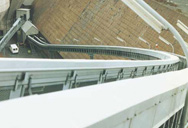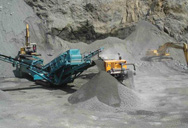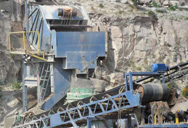


Chemical Formula Composition of Ball clay The Chemical formula of ball clay is Al 2 O 3. 2SiO 2.2H 2 O. The chemical composition of ball clay varies very much from place
Read More
Names: clay, ball clay: CAS #: 1332-58-7: Chemical formula: Al 2 O 3 2SiO 2 2H 2 O (main component) Functionality: OH: Chemical composition: SiO 2 − 53.3-61.2%, Al 2 O 3 − 24.3-32.5%, Fe 2 O 3 − 1.2-1.7%, TiO 2 − 1-1.1%, CaO − 0.2-0.3%, MgO − 0.2-0.4%, K 2 O − 0.3-1.3%, Na 2 O − 0.1-0.3%: PHYSICAL PROPERTIES: Density, g/cm 3: 2.6: Mohs hardness: 2-2.5
Read More
Ball clay is not a clay mineral in itself, but contains other minerals, primarily kaolinite (but also montmorillonite, halloysite, and illite). Mica and quartz are also present in substantial amounts (e.g. 10-20% for Tennessee ball clays). Ball clays are very plastic and much finer-grained than kaolins.
Read More
2006-1-1 Clay materials are composed of solid, liquid and vapour phases. The solid phases are of mineral and organic phases that make up the framework of the clay materials. The mineralogy can be broadly subdivided into the clay and non-clay
Read More
2020-10-13 considers, the clay as a mixture of Ooxides and that these sub stances may be present as silicates, carbonates, hydrates, sulfates, etc. 8i1ioo, it is claimed, will decrease the shrinkage and up to'
Read More
Abstract. Kaolin (or china clay), ball clay and bentonite are the dominant ‘industrial clays’, and are mined for a wide variety of uses ( Table 3.1 ), which exploit the special properties of each of the three clay types: Kaolin (china clay) — is chemically inert and can be prepared as a white powder specified (in part) according to its whiteness ...
Read More
2014-2-24 The mineralogical, chemical composition and ceramic properties of clay deposits from southern Thailand were studied to assess their potential for use in the ceramics industry. Samples were collected from 11 localities where clay mining and processing plants are active in southern Thailand. X-ray powder diffraction patterns with sample ...
Read More
2013-12-8 clay fraction usually exhibits poorer crystallinity, lower K+ content, higher water content, and possible substi-tutions of Fe2+ and Fe3+ in the octahedral sheets and Ca2+ in the interlayer. Manganese, vanadium, lithium, chro-mium, titanium, and several other cations are also known to occur in varying amounts in these fine-grained or clay-sized micas (1).
Read More
2 天前 Ions and molecules adsorbed on the clay mineral surface exert a major influence on the thickness of the adsorbed water layers and on the nature of this water. The nonliquid water may extend out from the clay mineral surfaces as much as 60–100 Å. Hydroxyl ions are driven off by heating clay
Read More
Ball clay is an extremely rare mineral found in very few places around the world. Its name dates back to the early methods of mining when specialized hand tools were used to extract the clay in rough cube shapes of about 30 cm. As the corners were knocked through handling and storage these cubes became rounded and ‘ball’ shaped.
Read More
2020-10-13 of far greater importance than is the chemical composition of the clay. It is claimed that the ordinary ultimate analysis only considers, the clay as a mixture of Ooxides and that these sub stances may be present as silicates, carbonates, hydrates, sulfates, etc. 8i1ioo, it is claimed, will decrease the shrinkage and up to'
Read More
To be able to estimate the probable fired properties of a given ball clay, it is not enough merely to know its chemical composition. It is also necessary to know how the various elements present are distributed as minerals - in other words, where the SiO 2 , Al 2 O 3 , Fe 2 O 3 and alkalis are known, the amount of each of these in combination ...
Read More
Ball clay is the main plastic material used in clay bodies of all types. It is much more plastic than kaolin but also has much higher dry shrinkage and higher iron content. A typical white high temperature stoneware is often about 25% each of kaolin, ball clay,
Read More
What are the main ingredients of clay? Between the five main minerals found in clay, kaolinite is the most common. Kaolinite holds the chemical composition Al2Si2O5 (OH)4 and is an aluminum silicate material with a low “shrink-swell” capacity. It is a soft, white mineral but
Read More
2014-2-24 The mineralogical, chemical composition and ceramic properties of clay deposits from southern Thailand were studied to assess their potential for use in the ceramics industry. Samples were collected from 11 localities where clay mining and processing plants are active in southern Thailand. X-ray powder diffraction patterns with sample ...
Read More
The selected locally sourced raw materials included: kaolin, feldspar, silica and ball clay. The Physical properties carried out on the specimens produced include chemical analysis, shrinkage, porosity, bulk density, modulus of rupture, plasticity and viscosity. The physical property tests were done in
Read More
2021-6-20 Composition of Clay Minerals: Clay minerals in soils belong to phyllosilicates group of minerals, which in turn belong to silicate minerals. Silicate minerals make up about 90% of the rock-forming minerals of the earth’s crust. The word Phyllon in the Greek means leaf and thus the silicate minerals having leaf or sheet-like structure with ...
Read More
Utilization of Sandy Clay "Kosarno" for other Raw Materials Production236 Кб. The type of the clay is ball clay, chemical composition (%): S1O2 52.02, AI2O3 27.78, F e 2 0 3 2.82, CaO 0.65, MgO 0.54, K 2 0 1.75, N a 2 0 0.2 andUsing the composites and feldspath and quartz sand replacements, the production costs are reduced.
Read More
Ball clay is an extremely rare mineral found in very few places around the world. Its name dates back to the early methods of mining when specialized hand tools were used to extract the clay in rough cube shapes of about 30 cm. As the corners were knocked through handling and storage these cubes became rounded and ‘ball’ shaped.
Read More
BALL CLAY is a variety of Kaolinite, like china-clay. It differs from china-clay in having high plasticity and less refractoriness. In chemical composition, Ball clays usually contain three dominant minerals: from 20-80% kaolinite, 10-25% mica, and 6-65% quartz.
Read More
What is the chemical composition of clay? Its composition is (K,H3O) (Al,Mg,Fe)2 (Si,Al)4O10 [ (OH)2, (H2O)]. Illite has an absence of swelling due to its tightly interlaced molecular spacing. It is a common mineral found in sediments, soils, and metamorphic rock. Click to see full answer.
Read More
Clay minerals contain bentonite, kaolin, fuller's earth, etc. Six types of clays are mined in the United States: ball clay, bentonite, common clay, fire clay, fuller's earth, and kaolin. Mineral composition, plasticity, color, absorption qualities, firing characteristics, and
Read More
What is the chemical composition of clay? Clay minerals are composed essentially of silica, alumina or magnesia or both, and water, but iron substitutes for aluminum and magnesium in varying degrees, and appreciable quantities of potassium, sodium, and calcium are frequently present as well.
Read More
1998-5-13 Clay minerals are very small, usually less than 4 µm in diameter, and have net negative sur-face charge (Brindley and Brown, 1980). Their high surface area and negative charge, providing large reaction surface and ion-exchange capacity, allow clay minerals to track relatively subtle changes in flu-id chemical composition.
Read More
What is the chemical composition of white clay Products. As a leading global manufacturer of crushing, grinding and mining equipments, we offer advanced, reasonable solutions for any size-reduction requirements including, What is the chemical composition of white clay, quarry, aggregate, and different kinds of minerals.
Read More
The selected locally sourced raw materials included: kaolin, feldspar, silica and ball clay. The Physical properties carried out on the specimens produced include chemical analysis, shrinkage, porosity, bulk density, modulus of rupture, plasticity and viscosity. The physical property tests were done in
Read More
